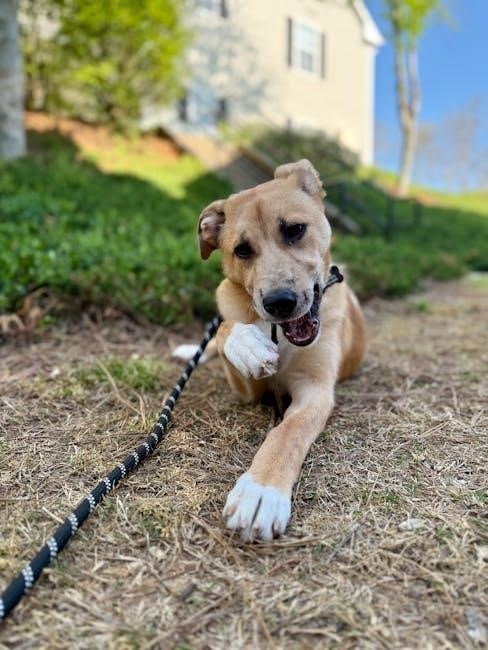The Baskerville muzzle is a popular choice for its humane design, breathability, and functionality, allowing dogs to pant, drink, and receive treats comfortably. Proper sizing is crucial for safety, comfort, and effectiveness. This guide provides detailed instructions on measuring, selecting the right size, and ensuring a perfect fit for your dog. Whether for training, behavior management, or safety, this guide helps you navigate the Baskerville muzzle sizing process with confidence.
Overview of Baskerville Muzzle
The Baskerville muzzle is a highly regarded tool for dog owners, offering a humane, breathable, and functional design. Its basket-style structure ensures dogs can pant, drink, and receive treats while wearing it. Designed for safety and comfort, it is ideal for training, managing aggression, or preventing unwanted behaviors like scavenging. The muzzle is lightweight, durable, and adjustable, with padded straps to prevent chafing. Available in various sizes, it accommodates small to large breeds, making it versatile for different needs. The Baskerville muzzle is widely recommended for its effectiveness and ease of use, providing peace of mind for both pet owners and those around them. Its innovative design sets it apart as a practical solution for responsible pet care.
Importance of Proper Muzzle Size
Proper muzzle size is essential for ensuring your dog’s comfort, safety, and the effectiveness of the muzzle. A muzzle that is too tight can cause discomfort or restrict breathing, while one that is too loose may not serve its intended purpose. Correct sizing ensures the muzzle remains secure without impeding your dog’s ability to pant, drink, or take treats. Improper fit can lead to distress or escape attempts, undermining training or behavioral management efforts. The Baskerville muzzle, with its humane design, relies on accurate sizing to balance functionality and comfort. Measuring carefully and selecting the right size guarantees a positive experience for both the dog and owner, making it a critical step in responsible pet care.

Why Proper Sizing is Crucial
Proper sizing ensures safety, comfort, and effectiveness, preventing discomfort or poor fit issues that hinder training and behavior management, aligning with the muzzle’s humane design.
Safety and Comfort for the Dog
The Baskerville muzzle is designed with the dog’s safety and comfort in mind, allowing them to pant, drink, and receive treats. Proper sizing ensures the muzzle sits flat on the nose, about half an inch from the eyes, preventing discomfort or injury. A well-fitted muzzle avoids skin irritation and stress, while an ill-fitting one can cause pain or restrict breathing. Incorrect measurements may lead to a muzzle that is too tight or too loose, compromising both safety and comfort. Ensuring the right fit is essential for the dog’s well-being and effectiveness of the muzzle. This balance is key to responsible pet ownership and training.
Functionality and Effectiveness
The Baskerville muzzle excels in functionality, allowing dogs to pant, drink, and receive treats, ensuring natural behavior isn’t hindered. Its breathable design promotes comfort while preventing biting or scavenging, making it ideal for training and behavior management. The muzzle’s effectiveness lies in its ability to balance restrictive needs with canine well-being. Proper sizing enhances functionality, ensuring the muzzle stays securely in place without obstructing essential actions. This design makes it a reliable tool for owners seeking to address behavioral issues while maintaining their dog’s quality of life. Its adjustable and padded features further contribute to its effectiveness as a humane training solution.
Step-by-Step Guide to Measuring Your Dog
To ensure the best fit, measure your dog’s muzzle width and length using a flexible measuring tape, following the Baskerville size guide for accuracy, ensuring comfort and functionality.
Measuring the Muzzle Width
To measure the muzzle width, wrap a flexible measuring tape around the widest part of your dog’s muzzle, typically just below the eyes and over the cheekbones. Ensure the tape is snug but not too tight, as this can restrict your dog’s comfort. The width measurement is critical for determining the correct size, as it ensures the muzzle sits properly without causing discomfort or restricting movement. For accuracy, take the measurement twice and use the average. This step is essential for selecting the right size from the Baskerville muzzle size chart, ensuring a secure and comfortable fit for your dog.
Measuring the Muzzle Length
To measure the muzzle length, place the tape measure from the tip of your dog’s nose to the base of the muzzle, just below the eyes. This ensures the muzzle will fit comfortably without obstructing your dog’s vision or causing discomfort. The length measurement is vital for ensuring the muzzle sits correctly and allows for proper breathing and movement. Take the measurement carefully, ensuring the tape is straight and not twisted. This step, combined with the width measurement, will help you select the most appropriate size from the Baskerville muzzle size chart, ensuring a secure and comfortable fit for your dog.
Baskerville Muzzle Size Chart
The Baskerville muzzle size chart categorizes sizes from 1 to 10, providing specific measurements for muzzle width and length to ensure a proper fit for various breeds and sizes.
Size Categories Explained
The Baskerville muzzle size chart is divided into categories to accommodate dogs of various breeds and sizes. Sizes range from 1 to 10, with each size corresponding to specific muzzle width and length measurements. Small breeds typically fit sizes 1-3, medium breeds sizes 4-6, and large breeds sizes 7-10. The chart ensures a tailored fit, allowing dogs to pant, drink, and take treats comfortably. Accurate measurements are crucial for selecting the correct size, as a proper fit ensures safety, comfort, and effectiveness. The chart also provides guidance for adjusting the muzzle to suit individual needs, making it a reliable tool for dog owners. Additional resources are available for further customization and fit troubleshooting.
Small, Medium, and Large Breed Measurements
Small breeds, such as Pugs and Chihuahuas, typically require muzzles with a width of 2-4 inches and length of 3-5 inches. Medium breeds, like Cocker Spaniels and French Bulldogs, need muzzles with a width of 4-6 inches and length of 5-7 inches. Large breeds, such as German Shepherds and Labradors, require muzzles with a width of 6-8 inches and length of 7-9 inches. These measurements ensure a comfortable and secure fit, allowing dogs to pant, drink, and take treats easily. Accurate sizing is essential for the muzzle’s effectiveness and the dog’s comfort, making breed-specific measurements a key factor in selection. Proper fit ensures safety and functionality for all sizes. Always refer to the official Baskerville size chart for precise guidance.
Factors Influencing Muzzle Size Selection
Breed-specific needs, weight, head shape, and behavioral requirements are key factors in selecting the right muzzle size. Proper fit ensures comfort, safety, and effectiveness for your dog.
Breed-Specific Considerations
Different dog breeds have varying muzzle shapes and sizes, making breed-specific considerations essential for proper fit. For example, brachycephalic breeds like Pugs may require a shorter muzzle, while longer-nosed breeds like Greyhounds need more length. Some breeds, such as Bulldogs, may have broader skulls, affecting how the muzzle sits. It’s important to consider the unique anatomy of your dog’s breed to ensure comfort and functionality. While the Baskerville size chart provides a general guide, breed-specific traits may necessitate adjustments. Always measure carefully and refer to breed-specific sizing tips to ensure the best fit for your dog’s muzzle shape and size.
Weight and Head Shape
A dog’s weight and head shape play significant roles in determining the ideal muzzle size. Heavier dogs may require a more secure fit to prevent shifting, while lighter dogs need a muzzle that isn’t overly bulky. Head shape varies greatly between breeds; for example, narrow-headed breeds like Greyhounds may need a slimmer muzzle, whereas broader-headed breeds like Bulldogs require a wider fit. Ensuring the muzzle aligns with your dog’s facial structure is crucial for comfort and functionality. Properly fitting the muzzle around the dog’s nose and head ensures it doesn’t press too hard or leave excessive room, balancing safety and comfort effectively.
Behavioral Needs
Behavioral needs are critical when selecting a Baskerville muzzle size. Dogs with aggressive tendencies require a secure fit to prevent biting, while nervous dogs need a muzzle that promotes comfort and reduces anxiety. The muzzle’s design allows for treat-based training, making it ideal for behavior modification. Proper sizing ensures the muzzle doesn’t restrict a dog’s ability to pant or drink, which is essential for calmness. For dogs prone to resource guarding or fear-based reactions, a well-fitted muzzle can provide peace of mind. Ensuring the muzzle aligns with your dog’s behavioral needs ensures effectiveness and supports positive reinforcement training strategies.
Adjusting the Muzzle for Perfect Fit
Adjust the muzzle by tightening or loosening the straps for a secure, comfortable fit. Heat-shaping allows customization to your dog’s unique muzzle shape for optimal comfort and safety.
Tightening and Loosening Adjustments
Properly tightening and loosening the Baskerville muzzle ensures a secure yet comfortable fit. Start by adjusting the straps to allow your dog to pant and drink easily. For a snug fit, tighten the straps gradually, ensuring no pressure points. If the muzzle feels too tight, loosen the straps slightly, making sure it doesn’t slip off. Regular checks are essential to maintain the right balance between safety and comfort. Always ensure your dog can move freely without the muzzle shifting. Adjustments should be made carefully to avoid discomfort or restriction of natural behaviors like panting or eating treats.
Heat-Shaping for Custom Fit
The Baskerville muzzle offers the unique feature of heat-shaping for a custom fit. To shape the muzzle, carefully heat it using a hairdryer or warm water until it becomes pliable. Gently mold the muzzle to match your dog’s muzzle shape, ensuring optimal comfort and alignment. Allow it to cool before use. This feature allows for precise adjustments, especially for dogs with unique head shapes. Always test the temperature to avoid discomfort and ensure safety. Heat-shaping enhances the fit without compromising the muzzle’s durability or functionality, making it an ideal solution for achieving a tailored fit for your dog’s specific needs.
Introducing the Muzzle to Your Dog
Introduce the muzzle gradually using positive reinforcement. Start by offering treats near the muzzle, then place it on your dog briefly, rewarding calm behavior. This builds trust and comfort, making the process stress-free for your dog.
Introducing the muzzle to your dog requires patience and positive reinforcement. Start by letting your dog explore the muzzle at their own pace, associating it with treats. Place a treat inside the muzzle or near it to encourage curiosity. Gradually increase exposure by placing the muzzle on your dog for short periods, rewarding calm behavior. Use verbal cues like “wear” to help your dog associate the action. Avoid forcing the muzzle on, as this can create anxiety. Instead, make it a positive experience by pairing it with rewards and praise. Over time, your dog will become comfortable with the muzzle, making training and use much easier.
Positive Reinforcement Techniques
Positive reinforcement is key to helping your dog accept the muzzle. Reward your dog with treats, praise, and affection when they exhibit calm behavior near or while wearing the muzzle. Begin by offering treats simply for sniffing or approaching the muzzle. Gradually progress to placing the muzzle near their face, then securing it for short periods. Use high-value rewards to associate the muzzle with positive experiences. Consistency and patience are essential; never rush the process. Over time, your dog will view the muzzle as a non-threatening tool, making training and use much less stressful for both you and your pet.

Common Mistakes to Avoid
Common errors include incorrect measurements, ignoring the dog’s comfort, and not following the size chart. Ensure accurate sizing and proper fit for optimal safety and functionality.
Incorrect Measurements
Incorrect measurements are a common mistake when fitting a Baskerville muzzle. Measuring improperly can lead to a muzzle that’s either too tight or too loose, compromising both comfort and functionality. To avoid this, ensure accurate measurements by placing the tape measure level around the widest part of the muzzle and from the tip of the nose to the base. Avoid guessing sizes; instead, refer to the provided size chart. If unsure, consider consulting a professional or reaching out to customer support for assistance. Proper fit is crucial for your dog’s safety and the effectiveness of the muzzle.
Poor Fit and Adjustments
A poor fit can lead to discomfort for your dog and reduce the muzzle’s effectiveness. If the muzzle is too tight, it may restrict breathing or cause skin irritation. Conversely, a loose fit can allow the muzzle to shift or be removed by the dog. To address this, ensure proper adjustments by tightening or loosening the straps as needed. The Baskerville muzzle is designed with adjustable features, allowing for a customized fit. Additionally, the muzzle can be heat-shaped to better conform to your dog’s unique facial structure. Regular checks and adjustments are essential to maintain comfort and functionality. Proper fit ensures safety and effectiveness for both the dog and those around them.

Troubleshooting Muzzle Fit Issues
Recognize and address fit issues promptly to ensure comfort and effectiveness. Adjust straps for proper snugness and use heat-shaping for a customized fit if necessary. Regular checks are essential for optimal performance and your dog’s well-being.
When the Muzzle is Too Tight
If the muzzle feels too tight, it can cause discomfort or restrict your dog’s ability to pant and drink. Check for signs like redness, irritation, or difficulty breathing. Loosen the straps gradually, ensuring the muzzle sits flat on the nose and remains about ½ inch away from the eyes. Avoid overtightening, as this can lead to stress or injury. If adjustments don’t resolve the issue, consider resizing or consulting the Baskerville size chart for a better fit. Proper fit ensures your dog’s safety and comfort while wearing the muzzle, making it essential to address tightness promptly to prevent long-term discomfort or behavioral issues.
When the Muzzle is Too Loose
If the muzzle is too loose, it may not function effectively, potentially allowing unwanted behaviors like biting or scavenging. A loose fit can also cause the muzzle to shift, risking discomfort or obstruction. To address this, tighten the adjustable straps to ensure a secure fit while maintaining comfort. Ensure the muzzle sits flat on the nose and does not impede breathing or vision. If minor gaps remain, heat-shaping the muzzle can provide a more tailored fit. However, avoid over-tightening, as this can cause discomfort. If the issue persists, consult the Baskerville size chart to determine if a smaller size is more appropriate for your dog’s measurements and needs.
Proper muzzle sizing ensures safety, comfort, and effectiveness. By following the Baskerville size guide, you can confidently select the best fit for your dog, promoting a stress-free experience for both you and your pet.
Final Thoughts on Muzzle Sizing
Accurate muzzle sizing is essential for your dog’s comfort and the effectiveness of the muzzle. The Baskerville muzzle offers a humane, breathable design, allowing your dog to pant, drink, and receive treats. Proper fit ensures safety and comfort, while incorrect sizing can lead to discomfort or reduced functionality. By carefully measuring your dog and referring to the size chart, you can select the ideal muzzle. Regular adjustments and training are key to a positive experience. Remember, a well-fitted muzzle promotes a stress-free environment for both you and your dog, making it an invaluable tool for training and behavior management.
Encouragement for Proper Fit
Ensuring your dog’s muzzle fits perfectly is a crucial step in promoting their comfort and cooperation. A well-fitted muzzle allows your dog to pant, drink, and enjoy treats while maintaining safety and control. By investing time in measuring and adjusting, you create a positive experience for your dog, reducing stress and anxiety. Proper fit also enhances the muzzle’s effectiveness, making it a reliable tool for training and behavior management. Remember, patience and consistency are key. With the right fit, your dog can thrive, and you can enjoy peace of mind knowing you’re providing a safe and humane solution.

Sources and Further Reading
For more information, visit the official Baskerville muzzle website or consult their sizing guide. Additional tips can be found in expert dog training resources and product reviews.
Recommended Resources
For comprehensive guidance, visit the official Company of Animals website, which provides detailed sizing charts and instructional guides. Additionally, reputable dog training websites and forums often share user experiences and tips for using Baskerville muzzles. Pet supply stores like PetShop.co.uk offer helpful sizing guides and product reviews. YouTube tutorials and expert blogs, such as The Labrador Site, also provide valuable insights. Consulting multiple sources ensures accurate and informed decisions for your dog’s muzzle needs.
Additional Tips and Guides
Beyond sizing, consider training resources like The Labrador Site for muzzle introduction tips. Positive reinforcement techniques, such as rewarding calm behavior, can ease your dog’s adjustment. For custom fits, Company of Animals offers guidance on heat-shaping muzzles. Always allow your dog to acclimate gradually, starting with short periods. Use treats to make the muzzle a positive experience. Regularly check the fit to ensure comfort and functionality. These additional strategies ensure your dog adapts well, making the muzzle a practical and humane tool for various situations.
